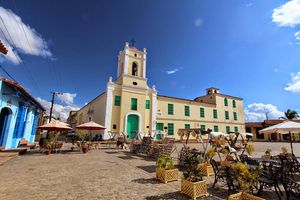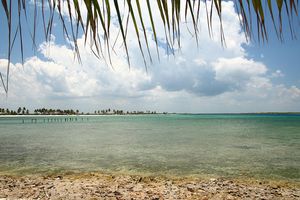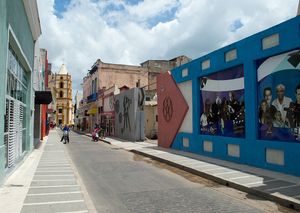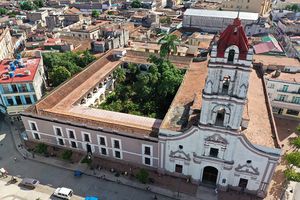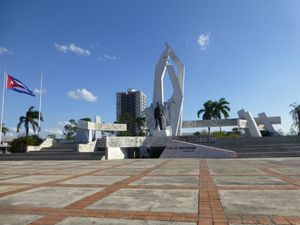

Camagüey, Cuba
Visit the Cuban province of Camagüey, a place of tropical beaches and history hidden in its magical corners
Camagüey is the easternmost, largest, and flattest province in the center of the island of Cuba. Its economy grew during the 17th century thanks to sugar production and cattle breeding. It has a few mountain groups and is flanked by the two largest archipelagos in the country: to the north, Sabana-Camagüey, known as the Jardines del Rey (Gardens of the King); and to the south, the Jardines de la Reina (Gardens of the Queen). Both still preserve virgin areas in which one can seek tranquility. The temperature does not vary excessively throughout the year with an average of 24.7 ºC.
Most tourists arrive at Ignacio Agramonte International Airport, or by road if they come from other regions of the country. The largest tourist attraction in the province of Camagüey is without a doubt, Santa Lucía Beach in Cayo Sabinal. The color of the water and the fine sand make a tropical attraction that few visitors to the island can resist. The local hotels add incentives to enjoy the beautiful beach by offering numerous activities to pass the time.
Other interesting places that you cannot miss on your trip to Camagüey are: Florida and its traditions, the Sierra del Chorrillo and its hiking trails, the history of the first cuban constitution in Guáimaro, or the industry of Nuevitas.
Camagüey is not just the beach. The most important city, that shares its name with the province, gives us the opportunity to discover the history of Cuba through its narrow labyrinth of streets that often bring us to its gorgeous hidden corners. It is also a place of visit for lovers of Catholic buildings, as it has great monuments.
Founded in 1514 as Santa María del Puerto Príncipe. The city moved several times due to bloody rebellions until 1528 when it settled in its current location. It was not until 1903 when it began to be called Camagüey. Due to the scarcity of water, the inhabitants of Camagüey, known as agramontinos, after the guerilla fighter that was born there, had to construct clay jars in order to catch the rain water. In addition to the guerilla fighter Ignacio Agramonte, the city has also given rise to personalities such as the poet Nicolás Guillén or el Doctor Carlos J. Finlay, who discovered the causes of the yellow fever.
Index
- What can I see in the city of Camagüey?
- What museums are in the city of Camagüey?
- What living accommodations are in Camagüey?
What can I see in the city of Camagüey?
Camagüey is characterized by its unique urban layout. Its labyrinthine streets, are more reminiscent of a moroccan medina than the gridded streets of the area. According to legend, the reason behind the winding streets and narrow, hidden alleys was that it was the solution found to centuries of conflict caused by pirates attacking the city. This peculiar layout was developed in order to confuse invaders and protect the locals.
There is one thing that is clear about Camagüey, which is its catholic soul, that the rest of the country lacks. As a result, among its narrow streets we discover a city of baroque churches and golden alters that you cannot miss. Some of these are the Cathedral of Our Lady of the Candalmas, constructed with the money raised during the visit of Pope John Paul II in 1998, or the Church of Our Lady of Mercy, the most impressive colonial church in Camagüey.
However, the vistor will not only find relgious buildings but also places full of culture like the Museum of Saint John of God located in the old hospital, that will refresh our knowledge of the history of Camagüey. During our visit to the city, we will not be able to forget the beautiful plazas and parks where we can enjoy a pleasant walk while stumbling upon historical monuments, the Plaza del Carmen or the Ignacio Agramonte park are some of them. Neither will we forget getting lost in its beautiful streets disocovering the charm of its hidden corners.
What museums are in the city of Camagüey?
You will find various museum options in Camagüey, the majority are dedicated to important figures, something that is not surprising due to the great history of the city.
The Museum of the House of Ignacio Agramonte’s is a beautiful colonial building dedicated to the life of Ignacio Agramonte, hero of the independance of Cuba, and the history of the city. Furthermore, it serves as a cultural activities center.
In the Museum of Saint John of God you can find elements of the histoy of Camagüey and some paintings of the locality. It is located in the plaza homónima, a place where there once was an old hospital.
Continuing on with museums dedicated to illustrious individuals, it is quite interesting to visit the The House of Carlos J. Finlay. You can learn a lot about the scientist Carlos Juan Finlay, known for his research on the yellow fever.
Finally, you can learn in depth about the the figure of Nicolás Guillén in the museum of The House of Nicolás Guillén. The avante garde author and activist is the most important poet of Cuba.
What living accommodations are in Camagüey?
In the city of Camagüey you will find many types of living arrangments. There are hotels with excellent locations in the center of the city such as the Hotel el Colonial, Hotel La Avellaneda or the Hotel Santa María, all of them located on the main street of the city.
In addition, other well situated four star hotels are the Hotel Camino del Hierro, Hotel el Marqués and the Hotel la Sevillana.
If you are looking for something more affordable and simple there are a variety of lower-end hotels that can suffice. In this category there is the Gran Hotel and others more affordable like the Hotel Camagüey, Hotel Colón, Hotel Plaza, Hotel Puerto Príncipe and the Hotel Isla de Cuba.
Interactive map:
Camagüey
What to see:
- City of Camagüey
- Plaza del Carmen Square
- Ignacio Agramonte Park
- Casino Campestre Park
- Nuestra Señora de la Candelaria Cathedral
- Iglesia de Nuestra Señora de la Merced Church
- Iglesia de Nuestra Señora de la Soledad Church
- Iglesia del Sagrado Corazón de Jesús Church
- Iglesia de Nuestra Señora del Carmen Church
- Florida
- Sierra del Chorrillo Mountains
- Guáimaro
- Constitución Park
- Nuevitas
- Río Máximo Wildlife Park
- Brasil
- Jardines del Rey
- Cayo Cruz
- Cayo Sabinal Cay
- San Hilario Fort
- Faro Colón Lighthouse
Beaches:
Museums:
Other nearby destinations:
Why "Trip Cuba"?
Trip Cuba is an organization of Cuban agencies whose objectives are:
- ✓ To make Cuba, its culture and its heritage known.
- ✓ To promote sustainable tourism.
- ✓ To support the local economy, prioritizing direct contact with Cuban agencies.
Travel Agencies
If you are a travel agency or tour operator and you are looking forward to any assistance or collaboration to plan trips to Cuba, rely on our extensive experience
Copyright www.TripCuba.Org © - All rights reserved
All our agencies are duly registered in the National Registry of Travel Agencies of the Chamber of Commerce of the Republic of Cuba.







